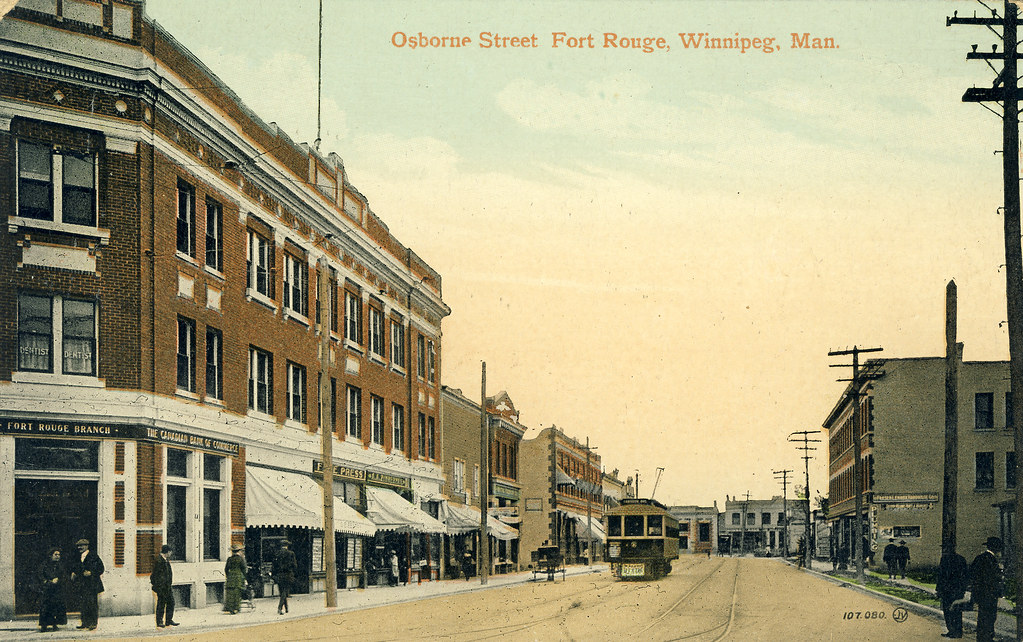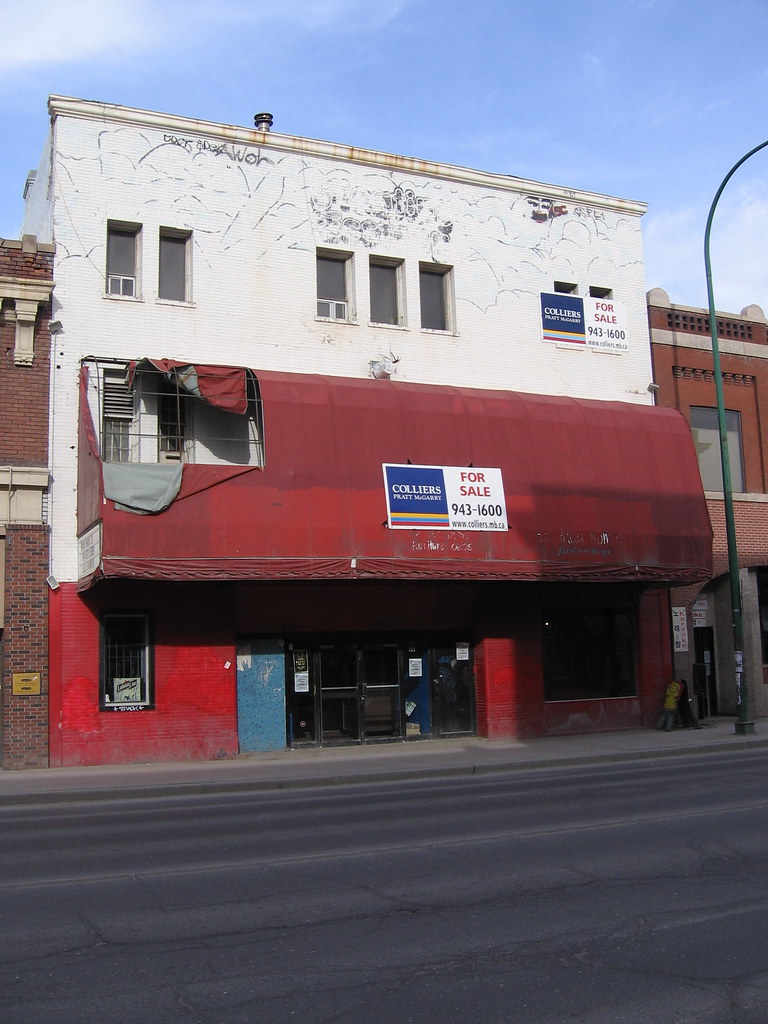Place: Former Osborne Theatre
Address: 108 Osborne Street
Opened: December 14, 1912
Architect: Ross and MacFarlane
Contractor: Carter Halls Aldinger
Ca. 1911, a gap on left side where the Osborne Theatre would be built (winterbos)
What we now call the Osborne Village neighbourhood of Fort Rouge transformed from a rural enclave into a city suburb between 1895 and 1905. After a few more years, there were enough residents to warrant its own neighbourhood theatre.
In August 1912 the Osborne Street Theatre Co. took out a $30,000 building permit to construct such an amenity. The company's principals included Edmund Burke, M. J. Williamson and Bruce Eggo.
November 16, 1912, Winnipeg Free Press
The architects were Ross and MacFarlane of Montreal. The firm had just designed a series of signature hotels for the Grand Trunk Pacific Railway, including the Chateau Laurier in Ottawa, Macdonald Hotel in Edmonton, and Hotel Fort Garry in Winnipeg. In later decades, it would count Maple Leaf Gardens and the Hotel Saskatchewan to its credit.The building's design was considered to be Sullivanesque with its symmetrical windows and ornamentation, though in this case stucco and plaster were used on the facade rather than terra cotta. The pattern on the front of the building was described as "oriental" with bands of red, blue and gold bordering the banks of windows and main entrance.
The 600-seat auditorium was meant to feel spacious with extra-wide aisles and additional space between seats so that patrons could spread out. A Free Press story called it "a new standard in interior arrangements."
1912 and 1916 offerings at the Osborne
The theatre opened on December 14, 1912 with a quadruple-bill of "photo plays" accompanied by a five piece orchestra. Interestingly, the Osborne was built as a cinema, or "photo play house", not a live theatre venue or a hybrid. It was among the first handful to be built in the city.
The third floor included space for offices and three apartments and there was a main floor retail unit that opened onto the street.
December 13, 1917, Winnipeg Free Press
In the early morning hours of December 12, 1917, fire struck the Osborne Theatre.
Newspaper stories carried the dramatic accounts of the residents of the three apartments, all women with children, escaping the building into the freezing cold in their night clothes. One had to jump with her child from the roof of the theatre building to the lower commercial block next door. They were taken to Augustine church for shelter until arrangements could be made with loved ones to take them in.
The fire, caused by an iron that was left plugged in, gutted the theatre and cost an estimated $80,000 in damages.
M. J. Williamson, the owner of the building, vowed to rebuild "bigger and better", though he wouldn't be the one to see the project through.
Raymond Kerhsaw, ca. 1915
While the building was still in ruins, Raymond Kershaw purchased it.
Kershaw was well known in theatre circles, having run the Wonderland theatre on Sargent Avenue for a number of years and as vice president of the Motion Picture Association of Manitoba, the theatre owners' trade organization.
Not long after taking over the Osborne he became the organization's president and opened the Tivoli on Maryland Street in 1927.
The Osborne's interior was rebuilt using steel lathe and hard plaster to make it "virtually fireproof" and the latest in air filtration systems kept patrons comfortable. The size of the main floor retail space was decreased to make a more spacious lobby.
A horseshoe-shaped balcony with two private loges could hold 250 more people than the old theatre.
Being independent theatres, Kerhsaw, who was joined in the business by his son Frank, did not have access to first-run studio films. To differentiate itself, in 1933 the Osborne specialized in showing British films.
In 1936, the Kerhsaws sold the two properties to Famous Players Ltd. and Raymond moved to Victoria.
Famous Players did not keep the theatres. Right after their purchase it bundled them with their other small theatres and sold them as a block to J. Miles' Western Theatre chain, who also owned the Roxy and Uptown. After the deal, Famous Players owned and operated just the Capitol and Metropolitan.
Frank Morriss, the Tribune's entertainment reporter, recalled in a 1968 column that while in Winnipeg on a tour, (no year was given but it was presumably in the mid-1930s while it was showing British fare), Laughton told him that he desperately wanted to see a film that was showing there.
He swore Morriss to tell no one so that he could be anonymous but Laughton was a very recognizable stars and was spotted immediately. Morriss recounted that "when we left the theatre we were pursued by a throng of curious fans."
October 20, 1958, Winnipeg Tribune
As with most neighbourhood theatres, television brought about the Osborne's demise in the 1950s. It stopped advertising in 1956 and in 1957 was put up for sale.
The main floor contained a lounge, dining area and cocktail bar. The second floor was the hall for 250 people that was also rented out for banquets. The top floor was the caretaker’s suite and offices.
The renovations cost about $135,000 and the Elk's Hall opened in February 1959.
The rental of the hall for rock concerts became an issue in late 1960s. Merchants petitioned to have them stopped, claiming that they attracted hippies and other undesirables to the area.
This was ironic as it was the hippie subculture that put what would become known as Osborne Village on the map. The merchants, however, were now trying to distance itself from the past and make the area more upscale.
The merchants and Elks battled it out at city hall in 1969 and 1970. The Elks left Osborne Street in 1971.
The building then became a retail block.
In December 1971, Vita Health, a health food shop that had operated on Kennedy Street for nearly 40 years, opened the “Garden of Eden” restaurant on the main floor of 108 Osborne. It specialized in health-food dishes and only lasted about a year.
In 1974, Dennis Stewart bought the building and relocated his Floating Ecstasy from 127 Osborne. The store specialized in waterbeds and wicker furniture. Around 1980, a branch opened on St. James Street and in 1984 the Osborne Village store was converted into the Sofa Shop by the same owner. When it closed in September 1986, the Floating Ecstasy reappeared for another year.
In November 1986, the second floor of the building became Yuk Yuk's Komedy Kabaret, the twelfth branch of the Toronto-based club.
Another tenant in the building from 1974 until at least 1987 was the Winnipeg Bridge Club.
In 1995, the night club was remade into Die Maschine by Gren Ross and Mark Janssen. In 1996, they turned the main floor into a second dance club called the Collective Cabaret.
Above: 2006 as Collective Cabaret (A Lorde) and in 2018
The clubs closed in August 2007 after the building was sold to a new owner. It was later announced that the space would become home to Winnipeg's first American Apparel store, which took up the main floor from December 2007 to December 2016, closing after the retailer's parent company went bankrupt.
In late 2017, the main floor space became an Anytime Fitness gym. The second floor remains a club.












No comments:
Post a Comment